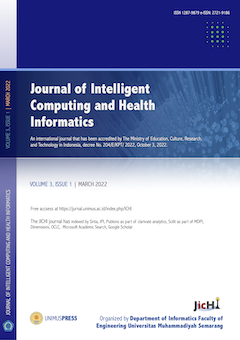Evaluation of Optima Regional Health Information System with HOT-Fit on Technology Aspects Approach in Johar Baru Health Center Jakarta
(1) Universitas Esa Unggul
(2) Universitas Esa Unggul
(*) Corresponding Author
Abstract
Keywords
Full Text:
PDFReferences
Anwar, N., Masrek, M. N., & Rambli, Y. R. (2012). Visitor Management system by applying the model of UTAUT. 2012 IEEE Symposium on Business, Engineering and Industrial Applications, 223–228. https://doi.org/10.1109/ISBEIA.2012.6422874
Ayanlade, O. S., Oyebisi, T. O., & Kolawole, B. A. (2019). Health Information Technology Acceptance Framework for diabetes management. Heliyon, 5(5), e01735. https://doi.org/10.1016/j.heliyon.2019.e01735
Erlirianto, L. M., Ali, A. H. N., & Herdiyanti, A. (2015). The Implementation of the Human, Organization, and Technology–Fit (HOT–Fit) Framework to Evaluate the Electronic Medical Record (EMR) System in a Hospital. Procedia Computer Science, 72, 580–587. https://doi.org/10.1016/j.procs.2015.12.166
Gunawan, H. (2018). Identifying Factors Affecting Smart City Adoption Using The Unified Theory of Acceptance and Use of Technology (UTAUT) Method. 2018 International Conference on Orange Technologies (ICOT), 1–4. https://doi.org/10.1109/ICOT.2018.8705803
Hakam, F. (2016). Analisis, Perancangan dan Evauasi Sistem Informasi kesehatan. Indonesia, P. R. (2014). Peraturan Pemerintah Republik Indonesia Nomor 46 Tahun 2014 Tentang Sistem Informasi Kesehatan. www.depkes.go.id/download.php
Isnawati, K., Nugroho, E., & Lazuardi, L. (2016). Implementasi Aplikasi Sistem Informasi Kesehatan Daerah ( SIKDA ) Generik Di UPT . Puskesmas Gambut Kabupaten. Journal of Information Systems for Public Health, 1(1), 64–71.
Jannah, L. M., & Salsabila, S. (2019). Evaluasi Penerapan SIKDA Optima Dengan Pendekatan HOT-Fit pada Aspek Sumber Daya Manusia di Wilayah Puskesmas Johar Baru Jakarta Pusat. Indonesian of Health Information Management Journal, 7(1), 16–21.
Kamal, S. A., Shafiq, M., & Kakria, P. (2020). Investigating acceptance of telemedicine services through an extended technology acceptance model (TAM). Technology in Society, 60(February), 101212. https://doi.org/10.1016/j.techsoc.2019.101212
RI, K. K. (2011). SIKDA Generik. Buletin Jendela Data dan Informasi Kesehatan Triwulan III ISSN 2088- 270X.
Sibuea, G. H. C., Napitupulu, T. A., & Condrobimo, A. R. (2017). An evaluation of information system using HOT-FIT model: A case study of a hospital information system. 2017 International Conference on Information Management and Technology (ICIMTech), 106–111. https://doi.org/10.1109/ICIMTech.2017.8273520
Singh, A., & Masuku, M. (2014). Sampling Techniques & Determination of Sample Size in Applied Statistics Research: an Overview. Ijecm.Co.Uk, II(11), 1–22. http://ijecm.co.uk/wpcontent/uploads/2014/11/21131.pdf
Susanto, G., & Sukakdi. (2011). Sistem Informasi Rekam Medis Pada Rumah Sakit Umum Daerah (RSUD) Pacitan Berbasis Web Base. Journal Speed – Sentra Penelitian Engineering Dan Edukasi, 3(4), 18–24.
Thenu, V. J., Sediyono, E., & Purnami, C. T. (2016). Evaluation of Health Center Management Information System to Support the Implementation of Generic SIKDA using HOT (fit) method in District of Purworejo. Jurnal Manajemen Kesehatan Indonesia, 4(2), 129–138. https://doi.org/10.14710/JMKI.4.2.2016.129-138
Tullah, R., & Hanafri, M. I. (2014). Evaluasi Penerapan Sistem Informasi Pada Politeknik LP3I Jakarta Dengan Metode Pieces. Jurnal Sisfotek Global, 4(1), 22–28. http://journal.stmikglobal.ac.id/index.php/sisfotek/article/ download/36/37
Yusof, M. M., Paul, R. J., & Stergioulas, L. K. (2006). Towards a Framework for Health Information Systems Evaluation. Proceedings of the 39th Annual Hawaii International Conference on System Sciences (HICSS’06), 95a-95a. https://doi.org/10.1109/HICSS.2006.491
Article Metrics
Abstract view : 1129 timesPDF - 295 times
DOI: https://doi.org/10.26714/jichi.v1i1.5397
Refbacks
- There are currently no refbacks.
____________________________________________________________________________
Journal of Intelligent Computing and Health Informatics (JICHI)
ISSN 2715-6923 (print) | 2721-9186 (online)
Organized by
Department of Informatics
Faculty of Engineering
Universitas Muhammadiyah Semarang
W : https://jurnal.unimus.ac.id/index.php/ICHI
E : [email protected], [email protected]








